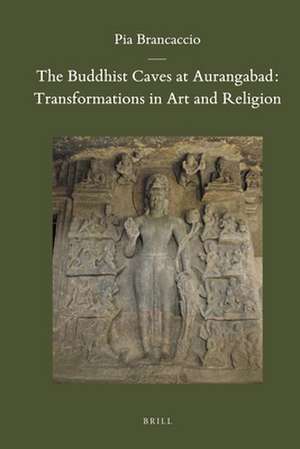The Buddhist Caves at Aurangabad: Transformations in Art and Religion: Brill's Indological Library, cartea 34
Autor Pia Brancaccioen Limba Engleză Hardback – 16 dec 2010
Din seria Brill's Indological Library
- 18%
 Preț: 1014.24 lei
Preț: 1014.24 lei - 18%
 Preț: 1137.16 lei
Preț: 1137.16 lei - 18%
 Preț: 919.14 lei
Preț: 919.14 lei - 18%
 Preț: 1139.18 lei
Preț: 1139.18 lei - 18%
 Preț: 941.25 lei
Preț: 941.25 lei - 18%
 Preț: 1030.17 lei
Preț: 1030.17 lei - 18%
 Preț: 1121.33 lei
Preț: 1121.33 lei - 18%
 Preț: 878.91 lei
Preț: 878.91 lei - 18%
 Preț: 679.75 lei
Preț: 679.75 lei - 18%
 Preț: 839.30 lei
Preț: 839.30 lei - 18%
 Preț: 729.48 lei
Preț: 729.48 lei - 18%
 Preț: 671.94 lei
Preț: 671.94 lei - 18%
 Preț: 672.47 lei
Preț: 672.47 lei - 18%
 Preț: 906.64 lei
Preț: 906.64 lei - 18%
 Preț: 749.60 lei
Preț: 749.60 lei - 18%
 Preț: 551.28 lei
Preț: 551.28 lei - 18%
 Preț: 937.08 lei
Preț: 937.08 lei - 18%
 Preț: 747.45 lei
Preț: 747.45 lei - 18%
 Preț: 835.21 lei
Preț: 835.21 lei - 18%
 Preț: 839.74 lei
Preț: 839.74 lei - 18%
 Preț: 763.28 lei
Preț: 763.28 lei - 18%
 Preț: 648.78 lei
Preț: 648.78 lei - 18%
 Preț: 832.86 lei
Preț: 832.86 lei - 18%
 Preț: 777.32 lei
Preț: 777.32 lei - 18%
 Preț: 631.23 lei
Preț: 631.23 lei - 18%
 Preț: 594.67 lei
Preț: 594.67 lei - 18%
 Preț: 926.53 lei
Preț: 926.53 lei - 18%
 Preț: 638.12 lei
Preț: 638.12 lei - 18%
 Preț: 687.54 lei
Preț: 687.54 lei - 18%
 Preț: 897.50 lei
Preț: 897.50 lei - 18%
 Preț: 836.26 lei
Preț: 836.26 lei - 18%
 Preț: 716.90 lei
Preț: 716.90 lei - 18%
 Preț: 633.56 lei
Preț: 633.56 lei - 18%
 Preț: 616.48 lei
Preț: 616.48 lei - 18%
 Preț: 776.54 lei
Preț: 776.54 lei - 18%
 Preț: 1266.22 lei
Preț: 1266.22 lei - 18%
 Preț: 709.25 lei
Preț: 709.25 lei - 18%
 Preț: 547.56 lei
Preț: 547.56 lei - 18%
 Preț: 674.70 lei
Preț: 674.70 lei - 15%
 Preț: 530.26 lei
Preț: 530.26 lei - 15%
 Preț: 530.38 lei
Preț: 530.38 lei - 15%
 Preț: 525.15 lei
Preț: 525.15 lei - 18%
 Preț: 557.97 lei
Preț: 557.97 lei - 18%
 Preț: 585.70 lei
Preț: 585.70 lei - 18%
 Preț: 922.68 lei
Preț: 922.68 lei - 18%
 Preț: 775.38 lei
Preț: 775.38 lei - 18%
 Preț: 1068.31 lei
Preț: 1068.31 lei
Preț: 721.77 lei
Preț vechi: 880.20 lei
-18% Nou
Puncte Express: 1083
Preț estimativ în valută:
138.12€ • 147.69$ • 115.15£
138.12€ • 147.69$ • 115.15£
Carte indisponibilă temporar
Doresc să fiu notificat când acest titlu va fi disponibil:
Se trimite...
Preluare comenzi: 021 569.72.76
Specificații
ISBN-13: 9789004185258
ISBN-10: 9004185259
Pagini: 332
Dimensiuni: 155 x 235 x 25 mm
Greutate: 0.61 kg
Editura: Brill
Colecția Brill
Seria Brill's Indological Library
ISBN-10: 9004185259
Pagini: 332
Dimensiuni: 155 x 235 x 25 mm
Greutate: 0.61 kg
Editura: Brill
Colecția Brill
Seria Brill's Indological Library
Notă biografică
Pia Brancaccio, Ph.D. (1995) in Indian Art and Archaeology, Universita' degli Studi di Napoli "L'Orientale", Italy, is Assistant Professor of Art History at Drexel University, Philadelphia. She has published extensively on Buddhist art and multicultural systems in ancient South Asia, with a special focus on Gandhara and the western regions of the Deccan plateau, including a book co-edited with Kurt Behrendt entitled Gandharan Buddhism: Archaeology, Art and Text (UBC Press, 2006).
Recenzii
'The title of this superb volume does not fully prepare the reader for its broad scope of relevance well beyond the site of Aurangabad for an understanding of Indian art, religious communities, and socio-economic history spanning eight hundred years (...) Pia Brancaccio not only provides a much-needed focused study, but she also follows the ramifications of the issues that arise from her examination of the site to lead the reader to international trade communities in Africa, Buddhist pilgrimage routes in China, related monasteries in Gandhara, and temples of the Pasupata sect of Saivism, to name but a few.(...) When she takes the site at its own terms, (...) Brancaccio meets the challenge and turns a bright light onto some of the most difficult passages of India's art history while offering cogent explanations to some of the toughest problems in the field.'
Sonya Rhie Quintanilla, San Diego Museum of Art, CAA.REVIEWS, 2012
Sonya Rhie Quintanilla, San Diego Museum of Art, CAA.REVIEWS, 2012
